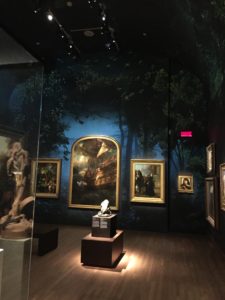
By Sylvia K. Miller and Hannah Jacobs
Some new trends emerge as Duke colleagues reflect on DH2017 in Montréal and contrast it with previous DH conferences. Following is a distillation of our observations in the form of a list of takeaways:
- Collaboration. There was more frequent reference to project partners, indicating more acceptance, even embracing of, collaboration. Many presenters explicitly, fully, gratefully thanked their team colleagues, showed their pictures on the screen, etc. Associated with this positive development for DH and humanities at large is concern over how collaborators are to be formally credited for publication and tenure.
- Diversity. The diversity workshop, for the first time open to all attendees, was a critical moment indicating that the community remains committed to addressing its diversity challenges.
- Librarians are more and more taking ownership of their role in enabling and supporting DH. I attended the “DH in Libraries” SIG meeting, and the lecture hall was quite full; I’d guestimate 200+ people. There were a number of projects to classify library/archive collections in new ways.
- TEI is more synonymous than ever with XML in the library world and world of DH scholarship. This is important for publishers to know if they are collaborating on multimodal projects that will have integrated library or repository components. (XML comes in different established schemas; TEI=Text Encoding Initiative.)
- “Phygital.” I heard more about the interplay between analog and digital forms, particularly 3D printing. (One paper called multimodal physical/digital projects “phygital,” though it is impossible to predict whether the term will stick!) The phenomenon of 3D printing of historical artifacts is fascinating and problematic: is it right to “copy” an artifact before returning it to the community from which it was stolen? (What if the artifact is a human bone?)
- Music/art. There was more art and music this year, though the emphasis of the conference is still more computational than artistic.
- Visualization. The expansion of visualization as an accepted DH practice stood out. There was an increased presence of visualization in its many forms; especially prevalent were node maps showing network relationships and geo-maps showing data sources or trajectories. Some of this work was also self-study (e.g., Taxonomy of Digital Research Activities in the Humanities, TADIRAH).
- Cultural heritage work was a theme. In Europe it is well funded, but systems developed there are not universally applicable; scholars working with American Indian communities find that digitization challenges and metadata schemas are very different in the US context.
- Overlaps. Several different teams around the world found that they are developing similar tools. At DH2015 in Sydney, there was a lot of special OCR work and machine-reading of historical texts with special scripts or other visual challenges. At DH2017, there seemed to be a significant amount of attention to adapting face-recognition software to recognition and comparison of other types of visual data (e.g., newspaper layouts, furniture/decorative arts, etc.).
- Publishing. The conference demonstrated a wide variety of computational, visual, and interactive scholarship that demands new modes of publication. Sylvia has noted some specific, if scattered, developments elsewhere; taken together, they remind us that scholarly publishing in its current form is seen by practitioners of DH as a barrier to growth and innovation.
- There was some AR and VR at the conference but not as much as one might expect. One exciting AR project stands out in retrospect, a project by Amanda Marie Licastro (Stevenson University, MD) to share the experience of Syrian refugees and create empathy in millennial students, who are, according to research, 40 percent less empathetic than earlier generations(!); in the Q&A session, she told a striking story about a student whose views were radically changed by the VR experience. I also heard about an exciting visualization project from Rachel Hendery of the University of Western Sydney, a projection of a node map inside a dome, where people can experience it together in 3D without having to wear 3D equipment.
- Funding. Mellon and NEH are the important funders of US work. European work is well funded by governments and the EU. There is a new government-funded DH initiative in South Africa.
- Peer review. There were many calls for proper peer review and recognition of DH as legitimate scholarship for promotion and tenure. One speaker mentioned that the University of Florida is the latest institution to create a DH peer review committee; content creators were asked to recommend a level of equivalency in terms of traditional scholarship on which the DH project should be evaluated. This was considered not ideal but perhaps a necessary interim step. (In this context, the Mellon-funded project at Brown University to evaluate digital scholarship at the department level seems especially interesting and ambitious.)
- Congenial spirit. There was a great deal of friendliness and mutual appreciation at this meeting; many scholars, especially graduate students, feel alone at their own institutions and appreciate meeting like-minded people. The group Tweeted up a storm! See #dh2017 (and @SylviaKMiller)
- Attendance. I heard that there were around 1,100 people at the meeting. I have not been able to confirm this online and have written to the ADHO–Alliance of Digital Humanities Organizations, the umbrella organization that hosts the conference.
- Future meetings. Next year the meeting will be in Mexico City, June 24–30, 2018; in 2019, Utrecht.
